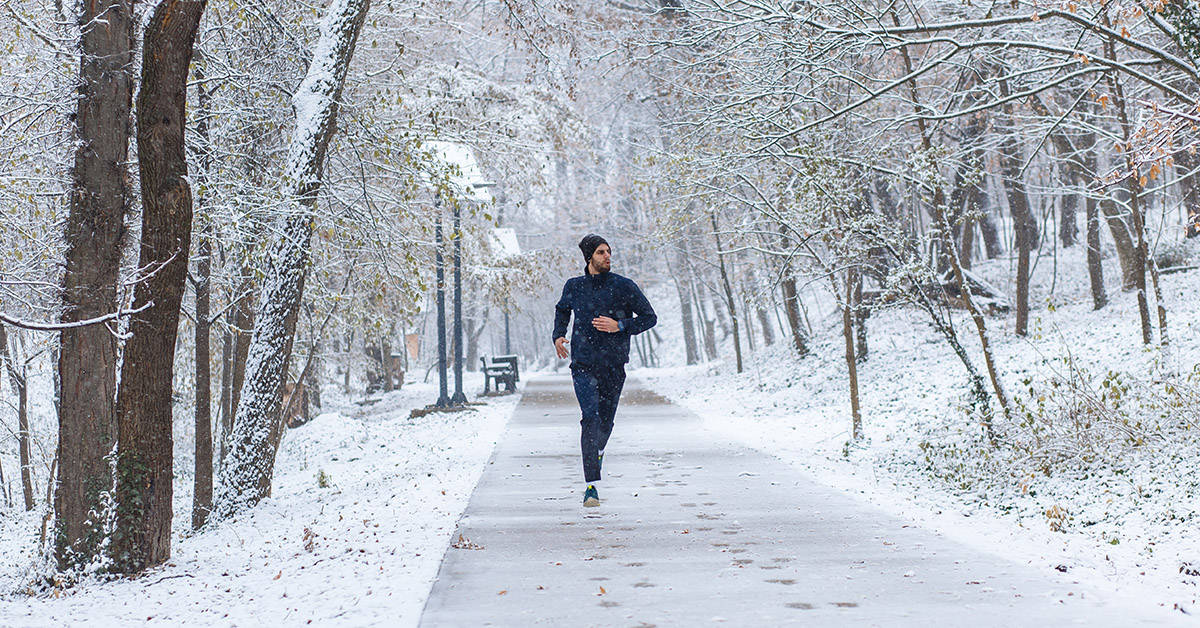Everything you need to know for dressing for winter running.
As fall turns to winter, it’s time to swap out your summer running gear for your winter running gear. Though running in the cold isn’t exactly dangerous, it can be uncomfortable if you’re not dressed appropriately. Correctly dressing for winter running will help you stay warm and will make your runs more enjoyable.
Here are a few basic guidelines for dressing for winter running.
1. Wear The Correct Fabric
When dressing for winter running, wear moisture-wicking clothing or wool clothing. Moisture-wicking and wool clothing pulls the water away from your skin and helps you retain your body heat. Fabrics like merino wool, nylon, and polypropylene are great for winter running.
Cotton clothing is your worst enemy for winter running. Cotton retains water (sweat) and keeps the moisture next to your skin. This draws the heat out of your body and makes you cold faster. If you’re out for an especially long or remote run, this could get dangerous and put you at risk of hypothermia. If you’re out for a short run around your neighborhood, it would just be uncomfortable. Either way, moisture-wicking fabric is much better for winter running.
2. Keep Your Core Warm
When you’re running in the winter, it’s important to keep your core warm. However, you don’t want to go overboard and accidentally make yourself too hot. When dressing for winter running, plan on wearing what you would if it was 10-20 degrees warmer. Your body heat will start to increase while you run, and you’ll start sweating more than you might think.
- Lightweight Long-Sleeved Shirt – Plan to run in a lightweight, moisture-wicking long-sleeved shirt. If you are running in especially cold temperatures, you might need a heavier shirt to keep your body heat trapped inside.
- Vest – If it’s cold enough that you would consider wearing a jacket while you’re running, try a vest instead. A lightweight vest like On’s Weather Vest can help you retain heat without overdoing it. It will also help protect you from the elements if it gets a little windy or drizzly.
3. Protect Your Extremities
Cold wind can make your run miserable if you’re not wearing the right clothing. It can bite at your ears and make your fingers and toes go numb, which is not a pleasant experience. Keeping your ears, fingers, and toes warm during your run will help you feel warmer and more comfortable overall.
- Ear Protection — Headband or Warm Hat
Wearing a warm hat like a beanie will help you retain more heat. However, if you find that a beanie makes your head too hot or that it makes you sweat too much, try a headband. For a little extra warmth, try something like Marmot’s Merino Wool Beanie or Saucony’s Fleece Headband. - Lightweight Gloves
Some lightweight wool or nylon gloves will help keep your fingers warm while you run. You shouldn’t need especially heavy or bulks gloves, just something that will help break the wind. - Merino Wool Socks
Wool socks draw the sweat away from your feet so that your feet don’t get as chilly. Since they also come in a variety of heights, you can choose a sock that offers varied levels of warmth. Darn Tough makes great merino wool socks deigned for running. They also have a unique lifetime warranty on their socks that most other companies don’t offer.
RELATED: Staying On Track With Running This Winter. Stay fit this winter with these training tips for keeping up your routine!
4. Protect Your Legs
You don’t lose much heat through your legs, so the primary concern for your legs is just comfort. Running in nylon or wool leggings will help your legs stay warm even if the wind is biting. If the wind and low temperatures aren’t too bad, basic yoga pants should do the trick. If it’s especially cold or windy, you might need something a little more durable. Something like Smartwool’s Merino Wool Baselayers are great for cold temps and windy days.
A Training Plan that Works for You.
Our collection of running plans will help you train year-round. From 5k to a 100-mile ultramarathon, we have a training plan built for your experience level and goals. Every plan is delivered via Final Surge, allowing you to sync workouts across devices, receive daily reminders of workouts and activities, and analyze workout and target zone details. Get started today with a training plan built for you, view our running plans here.









